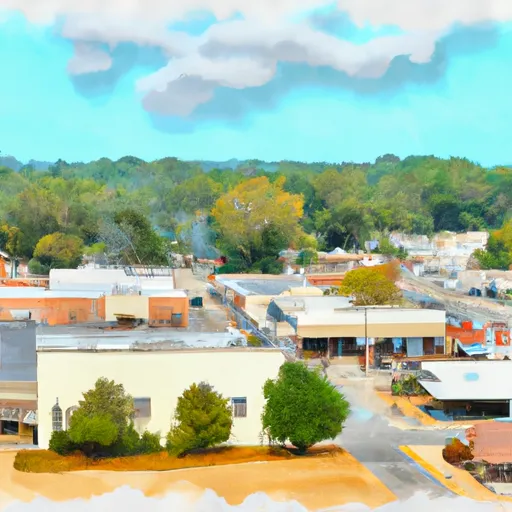-
 Snoflo Premium
Snoflo Premium
Get unlimited access to all our content
With no Ad interruptions! - Start Your Free Trial Login with existing account
Willacoochee
Eden Index
Climate
8.1
•
Recreation
2.4
•
Community
0.5
•
Safeguard
4.2/10

Willacoochee is a small town located in southern Georgia, known for its pleasant climate, diverse hydrology constituents, and a range of outdoor recreation opportunities. The town experiences a humid subtropical climate, with hot and humid summers and mild winters. Summer temperatures average around 90°F (32°C) while winter temperatures range from 30°F to 60°F (-1°C to 15°C). The region receives an average annual precipitation of around 50 inches, providing ample water resources for outdoor activities.
Willacoochee is home to the Willacoochee River, which flows through the town and offers opportunities for water-based activities such as fishing, kayaking, and canoeing. The river is abundant with various fish species, including bass, catfish, and bream, making it a popular spot for anglers. In addition to the Willacoochee River, the surrounding area features several lakes and ponds, providing additional options for water recreation.
The town is surrounded by picturesque landscapes, making it ideal for outdoor enthusiasts. There are numerous parks and nature reserves nearby, offering opportunities for hiking, camping, and wildlife observation. The Willacoochee Wildlife Management Area, located just a short distance from the town, features diverse habitats and is home to various wildlife species, making it an excellent destination for nature lovers.
Overall, Willacoochee provides a welcoming climate, a variety of hydrology constituents, and abundant opportunities for outdoor recreation, making it a charming destination for those who enjoy the outdoors.
What is the Eden Index?
The Snoflo Eden Index serves as a comprehensive rating system for regions, evaluating their desirability through a holistic assessment of climate health, outdoor recreation opportunities, and natural disaster risk, acknowledging the profound impact of these factors on livability and well-being.
Climate Health Indicator (CHI): 8.1
Willacoochee receives approximately
1223mm of rain per year,
with humidity levels near 85%
and air temperatures averaging around
19°C.
Willacoochee has a plant hardyness factor of
8, meaning
plants and agriculture in this region tend to thrive here all year round.
By considering the ideal temperature range, reliable water supplies, clean air, and stable seasonal rain or snowpacks, the Climate Health Indicator (CHI) underscores the significance of a healthy climate as the foundation for quality living.
A healthy climate is paramount for ensuring a high quality of life and livability in a region, fostering both physical well-being and environmental harmony. This can be characterized by ideal temperatures, reliable access to water supplies, clean air, and consistent seasonal rain or snowpacks.
Weather Forecast
Streamflow Conditions
St. Marys - Satilla
Area Rivers
St. Marys - Satilla
Snowpack Depths
St. Marys - Satilla
Reservoir Storage Capacity
St. Marys - Satilla
Groundwater Levels
Recreational Opportunity Index (ROI): 2.4
The Recreational Opportunity Index (ROI) recognizes the value of outdoor recreational options, such as parks, hiking trails, camping sites, and fishing spots, while acknowledging that climate plays a pivotal role in ensuring the comfort and consistency of these experiences.
Access to outdoor recreational opportunities, encompassing activities such as parks, hiking, camping, and fishing, is crucial for overall well-being, and the climate plays a pivotal role in enabling and enhancing these experiences, ensuring that individuals can engage in nature-based activities comfortably and consistently.
Camping Areas
| Campground | Campsites | Reservations | Toilets | Showers | Elevation |
|---|---|---|---|---|---|
| Gibson | None | 65 ft | |||
| Little Ocmulgee State Park | None | 202 ft | |||
| Otter Springs County Park | 100 | 19 ft | |||
| Hart Springs | None | 13 ft | |||
| Gornto Springs County Park | 24 | 20 ft | |||
| Suwannee River State Park | None | 74 ft | |||
| Ben Hill Landing County Park | None | 161 ft |
Nearby Ski Areas
Catastrophe Safeguard Index (CSI):
The Catastrophe Safeguard Index (CSI) recognizes that natural disaster risk, encompassing floods, fires, hurricanes, and tornadoes, can drastically affect safety and the overall appeal of an area.
The level of natural disaster risk in a region significantly affects safety and the overall livability, with climate change amplifying these risks by potentially increasing the frequency and intensity of events like floods, fires, hurricanes, and tornadoes, thereby posing substantial challenges to community resilience and well-being.
Community Resilience Indicator (CRI): 0.5
The Community Resilience Indicator (CRI) recognizes that education, healthcare, and socioeconomics are crucial to the well-being of a region. The CRI acknowledges the profound impact of these elements on residents' overall quality of life. By evaluating educational resources, healthcare accessibility, and economic inclusivity, the index captures the essential aspects that contribute to a thriving community, fostering resident satisfaction, equity, and social cohesion.

